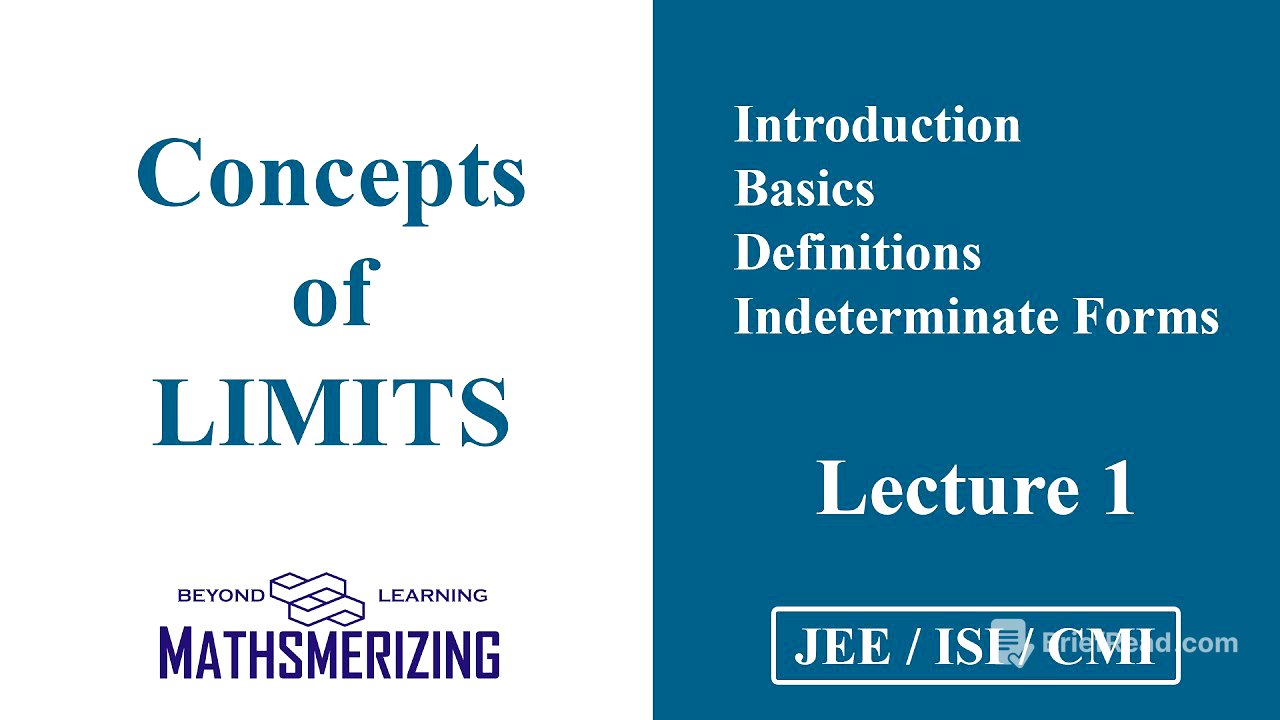TLDR;
This video serves as an introductory guide to limits in calculus. It explains why limits are important, covering basic definitions, informal and formal definitions of limits, indeterminate forms, and standard results. The video aims to build a strong foundation for understanding and solving limit problems.
- Importance of limits in calculus and real life.
- Basic definitions and notations used in limits.
- Understanding indeterminate forms and standard results.
Introduction | Why do we study limits? [0:00]
The video starts by explaining the importance of limits, drawing an analogy to Albert Einstein's quote about exceeding limits. In calculus, limits are essential for analysing functions that vary continuously or erratically. Limits help explore functions in the neighbourhood of a point where the function may not be defined. The concept of limits is used to find the slope of chords becoming tangents and to calculate the area under a curve by dividing it into infinite parts, which leads to differentiation and integration. Without limits, calculus would be restricted to trigonometry and coordinate geometry.
Basics [3:35]
Before diving into limits, the video explains the concept of the "neighbourhood of a point." The neighbourhood of a point 'a' includes all real numbers within a symmetrical open interval around 'a'. This interval is defined as (a - Delta, a + Delta), where Delta is the radius of the neighbourhood. The deleted neighbourhood of 'a' excludes the point 'a' itself. The video also defines left-hand and right-hand neighbourhoods. The notation "x tends to a" means x approaches 'a' but is not equal to 'a'. This approach can be from the left (x tends to a negative) or the right (x tends to a positive). The limit notation, lim x→a f(x) = L, means the value of the function f(x) approaches L as x approaches a.
Informal definition of limits [13:20]
The video provides an informal definition of a limit. If a function f(x) is defined in the deleted neighbourhood of 'a', and f(x) gets arbitrarily close to L for all x in the neighbourhood of 'a', then the limit of f(x) as x approaches 'a' is L. Graphically, as x approaches 'a' from the left or right, the function f(x) approaches the value L from both sides.
Formal definition of limits ( Epsilon delta definition) [15:24]
The video explains the formal (Epsilon-Delta) definition of a limit. The limit of f(x) as x approaches 'a' is L if for every Epsilon > 0, there exists a Delta > 0 such that if 0 < |x - a| < Delta, then |f(x) - L| < Epsilon. This means for any chosen neighbourhood around L (defined by Epsilon), there must be a corresponding deleted neighbourhood around 'a' (defined by Delta). The video provides an example to prove that lim x→2 (2x - 1) = 3 using the formal definition, showing how to find a suitable Delta for any given Epsilon.
Indeterminate forms [19:57]
The video introduces indeterminate forms, which are crucial in solving limit problems. These forms arise when direct substitution leads to expressions where the limit cannot be determined through the limiting behaviour of individual parts. The seven indeterminate forms are: 0/0, ∞/∞, ∞ - ∞, 0 * ∞, 1^∞, 0^0, and ∞^0. The video explains why 0/0 is indeterminate, noting that it represents "nearly 0 / nearly 0," which can take any value. Examples are provided to show how 0/0 can result in different finite values, plus or minus infinity, or may not be defined. The video also explains how ∞/∞ and 0 * ∞ can be transformed into the 0/0 form, making them indeterminate as well.
Some standard results [36:31]
The video discusses some standard results that can be derived from the properties of functions and their graphs. It examines the graphs of logarithmic functions (y = log_a(x)) for 0 < a < 1 and a > 1, determining the limits as x approaches 0+ and infinity. Similarly, it analyses the graphs of exponential functions (y = a^x) for 0 < a < 1 and a > 1, finding the limits as x approaches negative and positive infinity. The video also notes that sin(∞) and cos(∞) oscillate between -1 and 1. Finally, it presents properties of the greatest integer function and fractional part function, which are useful in solving limit problems.









